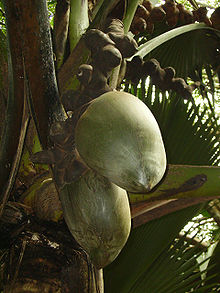Lodoicea

Lodoicea, commonly known as the sea coconut, coco de mer, or double coconut, is a monotypic genus in the palm family. The sole species, Lodoicea maldivica, is endemic to the islands of Praslin and Curieuse in the Seychelles. It formerly also was found on the small islets of St Pierre, Chauve-Souris and Ile Ronde (Round Island), all located near Praslin, but had become extinct there for a time until recently reintroduced. The name of the genus, Lodoicea, may be derived from Lodoicus, one Latinised form of Louis (typically Ludovicus), in honour of King Louis XV of France. Other sources say that Lodoicea is from Laodice, the daughter of Priam and Hecuba.[3]
The tree generally grows to 25–34 m tall. The tallest on record, measured on the ground after felling, was 56.7 m (186 ft) in total height.[4] The leaves are fan-shaped, 7–10 m long and 4.5 m wide with a 4 m petiole in mature plants. However juveniles produce much longer petioles; up to 9 m (30 ft)[5][6] or even 10 m (33 ft).[7] It is dioecious, with separate male and female plants. The male flowers are arranged in a catkin-like inflorescence up to 1 m long which continues to produce pollen over a ten-year period; one of the longest-living inflorescences known. The mature fruit is 40–50 cm in diameter and weighs 15–30 kg, and contains the largest seed in the plant kingdom. The fruit, which requires 6–7 years to mature and a further two years to germinate, is sometimes also referred to as the sea coconut, love nut, double coconut, coco fesse, or Seychelles nut.[8]
While the functional characteristics of Lodoicea are similar to other trees of monodominant forests in the humid tropics, its unique features include a huge seed, effective funnelling mechanism and diverse community of closely associated animals. These attributes suggest a long evolutionary history under relatively stable conditions.[9] Of the six monospecific endemic palms in Seychelles, Lodoicea is the “only true case of island gigantism among Seychelles flowering plants, a unique feature of Seychelles vegetation”.[10] It holds five botanical records: It produces the largest wild fruit so far recorded, weighing up to 42 kg (although domesticated pumpkins and watermelons can be much heavier); the mature seeds weighing up to 17.6 kg are the world’s heaviest,[11][12][13] The seed upon germinating, produces the longest known cotyledon, up to four meters (13 feet). The female flowers are the largest of any palm.[12][13] and Lodoicea is the most efficient plant known at recovering nutrients from moribund leaves.[14][15]
Of the six endemic palms it is the only dioecious species, with male and female flowers on different plants.[16]
